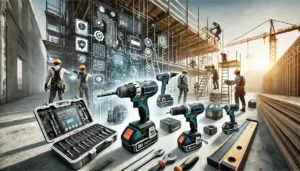An anchor is a tool that fastens anchors, keeping a vessel from being moved by external elements like wind, water current and mechanical stress. Various industries ship, construction, diy, and even portable projects utilize handles. The type of anchor selected is determined by the anchor’s specific location, the weight of the object, and the conditions in which it will be used. Knowing the different categories of anchors and their uses is important for ensuring safety and efficacy in their application.
1. Marine Anchors
The primary purpose of anchors in the maritime world is docking and mooring vessels to the seafloor to prevent drifting. The type of anchor selected depends on the type of sea bottom and the size of the boat.
- Plow Anchors: These are shaped like a plow and have sharp flukes which are used to dig into the sea bottom. They are used for sandy and muddy bottoms as they set quickly. Because of their strong holding power, medium and large vessels commonly use plow anchors.
- Fluke Anchors (Danforth Anchors): Lightweight fluke anchors have two flat rough edges pointing to the tip, which is a perfect fit for small boats, while also making it easy to store. Small flat designs make them easy to store. They hold best in muddy or sandy surfaces where strength is needed.
- Bruce Anchors (Claw Anchors): Good penetration and performance on rocky and weed covered sea floors makes Claw anchors so dependable. Their claw-like design makes them popular for all sizes of boats because they set and hold firmly besides capturing in different ocean bottom conditions.
- Mushroom Anchors: Mushroom anchors work best for deep sea floors as they keep moored boats offering high holding power deep into mud or silt. They seal great and permanently embed into the soft sea bottom for a long time, while sitting above without rotating. But these anchors are not preferable for shallow anchoring.
2. Construction Anchors
Just as in any other industry, anchors used in construction are important to hold various structural parts onto concrete and masonry. These anchors attach to subsurfaces that require a lot of stability but also some flexibility to withstand forces.
- Cast in place anchors: Ideal for High rise structures, these anchors are put in concrete while pouring. This method makes sure the anchor grips well and stays in position forever. Heavy machinery and equipment for construction are secured with these to make sure the anchors don’t detach.
- Post-Installed Anchors: These types of anchors are inserted to drilled holes and secured with adhesives or mechanical expansion once the concrete slab has cured. Post-installed anchors are perfect to fit fixtures on pre-existing structures. They are commonly used in renovation and maintenance projects for having a reliable hold while providing strong support.
- Chemical Anchors (Adhesive Anchors): Chemical adhesives are used to anchor a threaded rod or rebar to the base material. Such anchors are used where conventional mechanical anchors cannot be applied, or where minimal stress is desired. They are known for their high load capacities and environmental friendliness so they can withstand outer exposure.
3. Home Improvement Anchors
Anchors are commonly used in homes to fasten objects to walls, ceilings, or floors. They come in various types which differ in wall materials and load-bearing capabilities.
- Drywall Anchors: These anchors are usually plastic expansion anchors, toggle bolts or molly bolts, and are made for mounting items to drywall. They are carefully constructed to distribute weight and therefore, prevent damaged walls by the item mounted to it.
- Concrete Anchors: Concrete’s need for surface bolts requires that the bolts be mounted accurately on the concrete. This is done using sleeve anchors, wedge anchors and concrete screws. These can easily be installed onto concrete surfaces and look like a screw because of the head, making it easier to install shelves, handrails or even heavy machinery.
- Masonry Anchors: For use in brick or block walls, masonry anchors such as expansion anchors and screw-in anchors provide a secure hold for a wide range of household fixtures, ensuring items remain stable without damaging the structure.
4. Temporary Anchors
Temporary anchors are often used in applications that require short-term securing solutions. These anchors are designed for flexibility and ease of removal when no longer needed.
- Grapnel Anchors: Grapnel anchors feature multiple times, making them effective for dragging or securing smaller boats. They are well-suited for rocky or weedy seabeds, though they can be challenging to retrieve once set.
- Mud Weights: Mud weights are used in soft silt bottoms to resist lateral movement. They are typically used for temporary anchoring in calm conditions where other anchor types may not be effective.
5. Specialized Anchors
Certain applications require specialized anchors designed for specific conditions, ensuring strong and reliable holds in challenging environments.
- Auger Anchors: These auger anchors are designed in a way that enables them to drill into soft soils. This auger design provides superior grip for these anchors. These anchors are regularly used for permanent moorings, floating structures, and in offshore oil rigs.
- Deadweight Anchors: Deadweight anchors have one function only, which is to provide stability based on their weight. Deadweight anchors are used in conditions where other types of anchors are likely to fail. They are usually used in rocky, gravelly, or coarse sand bottoms where a secure grip is needed with no other machinery parts required.
- High-Holding-Power Anchors: These anchors are built for heavy-duty use in the harshest conditions possible. These types of anchors are common in the oil and gas industry. High-holding-power anchors are often used to secure large vessels, install pipelines and, more increasingly, to secure drilling platforms.
Conclusion
Knowing various kinds of anchors and how they should be used is critical in choosing the right anchor for a given job. The choice of anchor is heavily dependent on the environment, the weight of the item that is to be secured and the forces that are likely to act on it. Whether you are anchoring a ship in a harbor, fastening machinery in a building site, or bolting appendages on a house, using the right type of anchor guarantees safety and stability. Anchor design has changed over the years to suit different industries, becoming more efficient, reliable, and adaptable to a wider range of uses.










